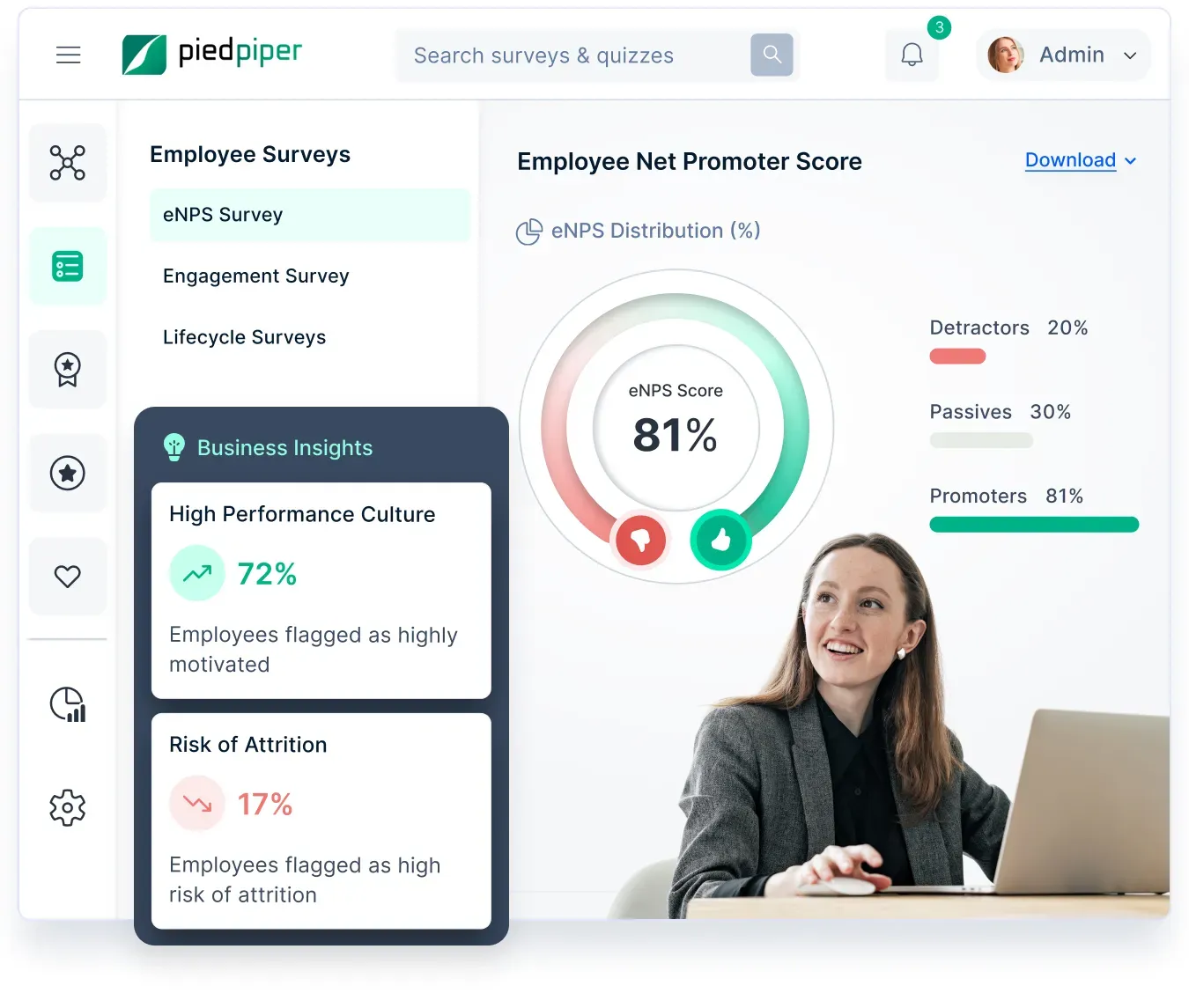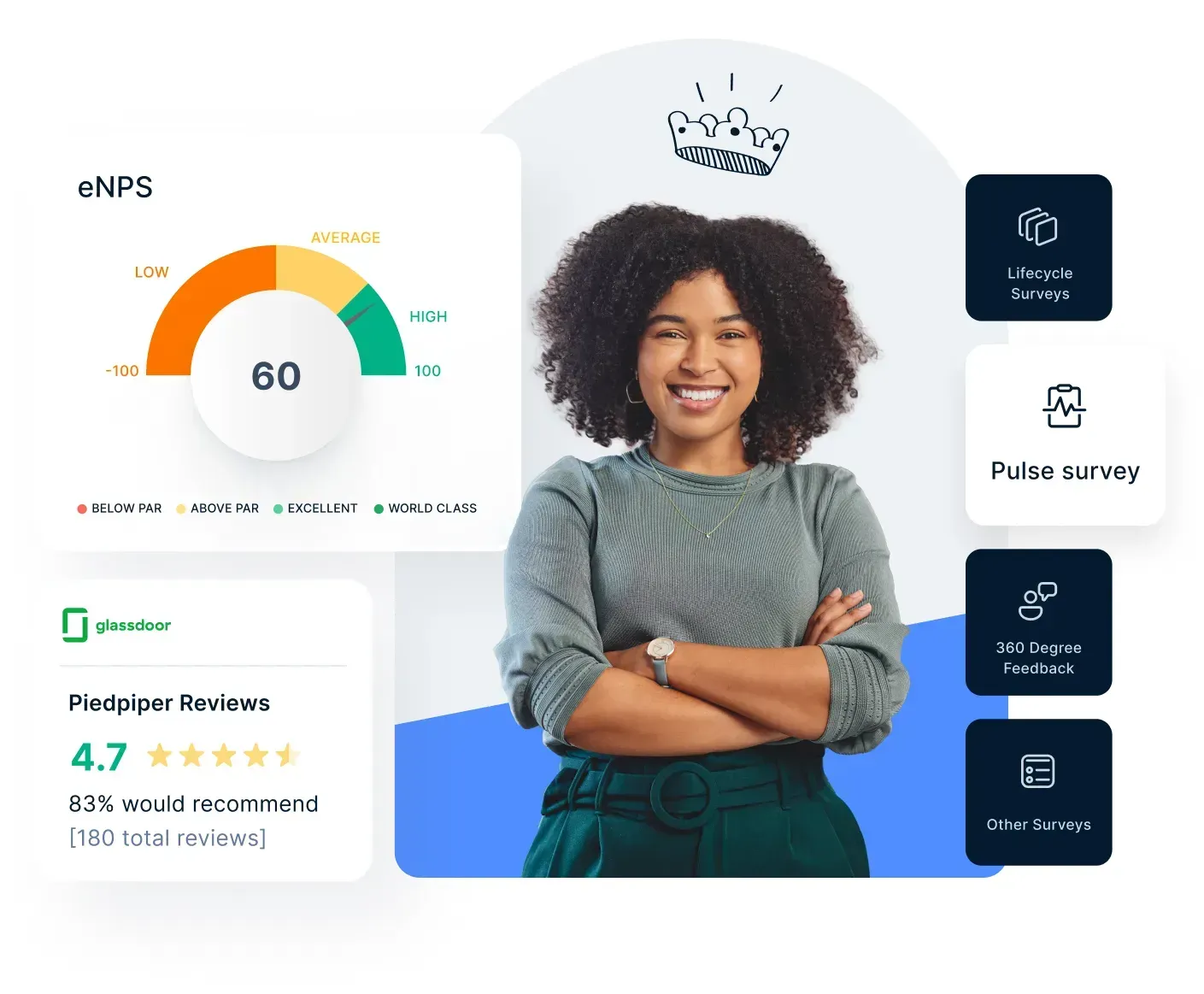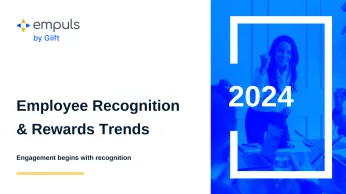30 exemples de feedbacks d'employés pour des conversations positives et constructives
Donner du feedback de la bonne manière aide les employés à se développer et à rester engagés. Ce blog présente des exemples de feedbacks aux employés, y compris des feedbacks positifs et constructifs, afin de garantir des conversations claires et efficaces.
Sur cette page
- Cadres pour un retour d'information efficace sur les salariés
- 20 exemples de feedback positif aux employés
- Comment donner un feedback négatif ?
- Exemples de commentaires négatifs à l'intention des employés
- Créez vos propres exemples de retour d'information
- Quand donner du feedback ?
- Il est temps d'instaurer une culture du feedback positif dans votre organisation !
- Principaux points à retenir
Une question essentielle que tout manager devrait se poser : Vos employés savent-ils ce qu'ils font bien et ce qu'ils doivent améliorer en permanence ? Un retour d'information régulier est essentiel pour maintenir les employés sur la bonne voie, les mobiliser et les aligner sur les objectifs de l'entreprise. Il leur permet de mieux comprendre leur rôle, ce qui est un facteur clé de la satisfaction et de la performance des employés.
Cependant, le retour d'information n'est efficace que s'il est fourni de la bonne manière. Sans structure, c'est comme si l'on envoyait des employés faire un voyage en voiture avec une carte périmée et sans panneaux indicateurs - cela crée de la confusion, de la frustration et de l'inefficacité. L'essentiel est de trouver le bon équilibre entre le rétroaction des employés qui renforcent les bons comportements et les exemples de feedbacks négatifs qui guident les améliorations nécessaires.
Alors, à quoi ressemble un retour d'information efficace ? Vous vous demandez peut-être quoi dire, comment et quand le faire. Dans ce blog, nous allons explorer des exemples de retour d'information sur les employés, en expliquant pourquoi ils fonctionnent et comment vous pouvez les utiliser pour créer des conversations constructives et percutantes avec votre équipe.
Cadres pour un retour d'information efficace sur les salariés
Le retour d'information est essentiel pour le développement des employés, mais la manière dont vous le donnez détermine son efficacité. Une approche structurée garantit que le retour d'information est clair, constructif et exploitable. Deux modèles largement reconnus pour donner un retour d'information - le modèle Situation-Comportement-Impact (SBI) et le modèle de retour d'information de McKinsey - aident lesmanagers àcommuniquer un retour d'information pour minimiser l'attitude défensive et maximiser l'amélioration.
L'utilisation de ces cadres garantit que le retour d'information est fondé sur des faits, évite les hypothèses et se concentre sur les comportements plutôt que sur les traits de caractère. Examinons les deux modèles en détail.
1. Modèle SBI : Situation-Comportement-Impact
Le modèle SBI est l'un des cadres de retour d'information les plus utilisés dans les grandes organisations. Il aide les managers à fournir un retour d'information à la fois positif et constructif en se concentrant sur trois éléments clés :
- Situation : Précisez quand et où le comportement s'est produit. Fournir un contexte aide le destinataire à se souvenir de l'événement et à comprendre le retour d'information dans le bon cadre de référence. Au lieu de faire des déclarations vagues, mettez le doigt sur un moment précis, comme une présentation de projet récente ou une réunion d'équipe.
- Comportement : Décrire clairement le comportement observé sans porter de jugement personnel. L'objectif est de se concentrer sur les faits plutôt que sur les hypothèses ou les interprétations. Par exemple, au lieu de dire "Vous avez été négligent", dites "Vous avez omis quelques points de données clés dans votre rapport".
- L'impact : Expliquez comment le comportement a affecté l'équipe, le projet ou l'organisation. Cela renforce la raison pour laquelle le retour d'information est important et fournit une motivation pour le changement ou le renforcement.
Exemple de retour d'information positif à l'aide du modèle SBI:
"Lors de la réunion de lundi avec le client (S), vous avez présenté la proposition révisée avec assurance et répondu clairement à toutes les préoccupations (B). En conséquence, le client est maintenant plus confiant quant à l'augmentation de son investissement avec nous (I). Bon travail !"
Exemple de retour d'information constructif à l'aide du modèle SBI:
"Au cours de la séance de brainstorming d'hier (S), vous avez interrompu un collègue à plusieurs reprises alors qu'il partageait ses idées (B). Cela l'a empêché de contribuer pleinement à la discussion (I). À l'avenir, veillons à ce que chacun ait la possibilité de s'exprimer."
Cette approche garantit que le retour d'information est spécifique, évite les attaques personnelles et permet aux employés de comprendre et d'agir plus facilement.
2. Modèle de rétroaction de McKinsey (modèle X-Y-Z)
Le modèle de retour d'information de McKinsey, également connu sous le nom de modèle X-Y-Z, est un autre cadre efficace conçu pour que le retour d'information soit fondé sur des faits et exploitable. Il suit cette structure simple :
- X (Ce qui s'est passé) : Décrivez l'action ou l'événement spécifique qui s'est produit.
- Y (Impact du comportement) : Expliquez comment le comportement a affecté les autres ou l'issue d'une situation.
- Z (changement ou amélioration attendus) : Fournir des orientations claires sur ce qui devrait être fait différemment à l'avenir.
Exemple de retour d'information à l'aide du modèle McKinsey:
"Vendredi dernier, vous êtes arrivé en retard à notre réunion d'équipe hebdomadaire (X), ce qui a provoqué de la frustration car nous avons dû bâcler l'ordre du jour, ce qui nous a fait manquer des points de discussion (Y). À l'avenir, veuillez nous informer à l'avance si vous prévoyez d'être en retard afin que nous puissions nous adapter en conséquence (Z)".
Ce modèle permet d'éviter les malentendus en se concentrant sur les actions observables plutôt que sur les opinions personnelles. Il prévoit également une étape suivante claire, ce qui facilite la mise en œuvre du retour d'information par les employés.
Pourquoi utiliser ces cadres de retour d'information ?
Le modèle SBI et le modèle de retour d'information de McKinsey garantissent que le retour d'information est structuré, sans jugement et basé sur des faits. Voici pourquoi ils fonctionnent :
- Réduit l'attitude défensive : Les employés sont moins susceptibles de prendre le feed-back personnellement lorsqu'il porte sur des comportements spécifiques et leur impact.
- Encourage les discussions constructives : Le retour d'information devient une conversation à double sens, permettant aux employés de réfléchir et de répondre sans se sentir attaqués.
- Fournit des attentes claires : Les employés comprennent précisément ce qu'ils doivent continuer à faire ou améliorer.
En adoptant ces cadres de retour d'information structurés, les managers peuvent créer une culture d'entreprise où le retour d'information n'est pas redouté mais accueilli comme un outil de développement. Qu'il s'agisse de renforcer les comportements positifs ou d'orienter les améliorations, ces modèles contribuent à rendre chaque conversation sur le retour d'information plus efficace et plus percutante.
Maintenant que vous savez comment donner un retour d'information à vos employés, examinons quelques exemples honnêtes de retour d'information !

Des modèles d'enquêtes auprès des salariés prêts à l'emploi pour des informations instantanées
Gagnez du temps et obtenez le bon retour d'information grâce aux modèles d'enquête d'Empuls. Choisissez parmi une variété d'enquêtes préconçues pour mesurer l'engagement, la satisfaction et la culture du lieu de travail - personnalisables en fonction des besoins de votre organisation.
Télécharger maintenant
20 exemples de feedback positif aux employés
Voici 20 exemples de commentaires positifs de la part des employés.
1. Un employé qui s'acquitte d'une responsabilité massive avec le plus grand dévouement.
Les nouveaux employés ont généralement besoin d'une formation pour s'acclimater à leur nouvel environnement professionnel. Les membres de l'équipe chargés de mener à bien ces programmes de formation doivent faire face à de nombreuses questions émanant de personnes différentes. Ils méritent donc un retour d'information positif.
✅ Pour les apprécier, vous pouvez les complimenter : "Vous avez assumé une énorme responsabilité pour l'équipe et aidé à former nos nouveaux coéquipiers avec le plus grand dévouement et le plus grand engagement. J'apprécie sincèrement les efforts supplémentaires que vous avez déployés pour aider les nouveaux employés à s'intégrer rapidement."
2. Un employé a géré une situation compliquée et a trouvé des solutions aux conflits.
Lorsqu'ils collaborent à un projet, les coéquipiers peuvent souvent s'opposer en raison de leurs approches différentes, ce qui entraîne des divergences. Toutefois, si les employés prennent l'initiative de dépasser tous les conflits et de trouver des solutions pratiques pour que le travail se poursuive, ils méritent un retour d'information positif.
Dans ce cas, vous pouvez dire : "J'apprécie sincèrement les efforts que vous avez déployés pour résoudre les désaccords et trouver des solutions acceptables pour tous les membres et parties prenantes concernés. Nous reconnaissons que cela n'a pas été facile, mais vous l'avez bien géré. C'est du bon travail !
3. Un employé qui est surchargé de travail supplémentaire
Il peut arriver que les ressources soient insuffisantes et que, pour cette raison, de nombreux employés disponibles n'aient d'autre choix que d'accepter un travail supplémentaire. Au fil du temps, cela peut conduire certains d'entre eux à devenir très stressés et, finalement, à à démissionner discrètement.
Dans ce cas, vous pouvez dire : "Je suis conscient de l'intensité de votre travail depuis deux semaines et j'apprécie sincèrement vos efforts. Votre travail reprendra bientôt son cours normal et vous serez rémunéré à juste titre pour vos heures supplémentaires. Continuez à bien travailler !"
4. Un employé dont le travail acharné est passé inaperçu
Quelques employés de votre organisation travaillent toujours sans relâche pour produire les meilleurs résultats. Ils fournissent constamment un travail de qualité, quoi qu'il arrive, mais passent parfois inaperçus.
Dans ce cas, vous pouvez dire : "J'apprécie que vous ne manquiez jamais les délais et que vous contribuiez constamment à faire avancer les choses pour nous. Vous prenez plaisir à votre travail car cela se reflète dans la qualité de vos livrables à chaque fois. Nous apprécions vraiment que vous fassiez partie de notre équipe."
5. Un employé qui va au-delà de ses capacités pour atteindre ses objectifs
En raison des délais stricts, les employés se retrouvent souvent avec une charge de travail importante. Il convient donc d'apprécier les employés qui vont au-delà de leurs capacités habituelles pour produire des résultats dans les délais impartis ou avant.
Dans ce cas, vous pouvez dire : " Je sais que vous avez récemment été affecté à des travaux supplémentaires. Vous avez réussi à les livrer à temps pour atteindre nos objectifs hebdomadaires, ce qui, j'en suis conscient, pourrait être difficile compte tenu des délais stricts. Je vous remercie sincèrement pour votre dévouement sans faille.
6. Un employé qui ne se sent pas apprécié à sa juste valeur pour ses efforts.
Parfois, les employés qui travaillent dur peuvent aussi se retrouver dans des situations difficiles où ils se sentent insignifiants ou peu appréciés pour leurs efforts. Vous devez leur fournir un retour positif pour les aider à sortir de ces pièges mentaux.
Dans ce cas, vous pouvez dire : "Au cours des dernières semaines, vous avez non seulement exécuté efficacement les tâches qui vous ont été confiées, mais vous avez également contribué de manière significative à la réussite du dernier projet de notre équipe. Nous vous remercions d'avoir donné un tel exemple à vos coéquipiers. Bon travail !"
7. Un employé a dépassé vos attentes
Rechercher des stratégies spécifiques liées à un projet et trouver les stratégies appropriées peut prendre un temps considérable. Si un coéquipier dépasse vos attentes et propose plusieurs stratégies intéressantes afin que vous puissiez prendre de meilleures décisions d'affaires, n'hésitez pas à l'applaudir par des commentaires positifs.
Dans ce cas, vous pouvez dire : "Votre sincérité et votre dévouement à l'égard de ce projet sont louables. Vous avez fait un excellent travail de recherche et proposé des stratégies efficaces en si peu de temps. Merci pour votre engagement envers les objectifs communs de notre équipe."
8. Un employé a pris une initiative importante pour toute l'équipe.
De nos jours, la moitié du monde de l'entreprise ne profite pas des occasions de nouer des relations sociales. Les employés ont du mal à comprendre leurs coéquipiers en raison d'un manque de communication adéquate. C'est le résultat de l'incorporation d'environnements de travail hybrides et à distance après le déferlement de la pandémie de COVID-19.
Si un coéquipier prend l'initiative d'organiser des séances de socialisation virtuelles où les employés ont la possibilité de nouer des relations solides, cela appelle des commentaires positifs de grande envergure.
Dans ce cas, vous pouvez dire : "De nombreux employés avaient peur de manquer quelque chose car ils n'avaient pas assez d'occasions d'interagir et de se connecter avec leurs collègues. Toutefois, l'organisation de séances de socialisation virtuelles a grandement contribué à favoriser les relations interpersonnelles entre les membres de l'équipe. Merci d'avoir eu un impact aussi important et d'avoir rapproché notre équipe plus que jamais."
9. Un employé a toujours fait de son mieux pour atteindre les objectifs de l'organisation.
Si vous avez remarqué que votre employé a toujours atteint tous ses objectifs dans les délais, il mérite vraiment d'être apprécié. Un retour positif de votre part renforcera ce sentiment de réussite.
✅ Pour les honorer, vous pouvez dire : " J'ai remarqué qu'au cours des dernières semaines, tu as atteint tous tes objectifs dans les délais impartis ou avant. Pour tous les autres coéquipiers, c'est un excellent exemple. Vos compétences en matière de gestion et votre capacité à reconnaître vos limites tout en faisant un effort supplémentaire prouvent que vous serez un membre précieux de notre équipe pendant longtemps."
10. Un employé vous a aidé à éviter à votre entreprise de gaspiller des ressources supplémentaires
Imaginons qu'un employé ait trouvé des solutions pratiques pour résoudre un problème qui aurait pu nuire à votre entreprise. Ces solutions se sont avérées efficaces et ont permis à votre entreprise de gagner du temps et de l'argent.
Dans ce cas, vous pouvez dire : "Nous apprécions sincèrement la rapidité avec laquelle vous avez trouvé une solution à ce problème. Votre volonté d'entreprendre des situations risquées et de porter des jugements rapides nous a épargné une grande catastrophe. Je suis ravi de vous avoir à bord !"
11. Un employé prend l'initiative de maintenir la communication entre les employés
Toute entreprise prospère a besoin d'employés qui savent communiquer. Favoriser des relations efficaces entre les membres du personnel peut les motiver à être encore plus performants. Une communication efficace entre les employés est une compétence sur laquelle les employés performants capitalisent.
✅ Lorsque vous remarquez que votre employé prend des initiatives, vous pouvez dire : "J'apprécie la façon dont vous m'avez activement tenu informé de l'avancement des tâches de cette semaine. Cela a considérablement réduit le temps que j'ai dû consacrer à la communication et à la coordination avec les parties prenantes du projet. Votre productivité et vos compétences en matière de communication sont tout à fait impressionnantes."
12. Un employé vous a surpris par sa persévérance
Parfois, les employés finissent par vous surprendre en faisant preuve de compétences exceptionnelles au travail. Cela vous aide à les orienter pour qu'ils atteignent leur potentiel et obtiennent de meilleurs résultats pour votre organisation.
Dans ce cas, vous pouvez dire : " Les objectifs que vous avez atteints ce mois-ci me rendent véritablement fier. Vous avez démontré vos compétences uniques avec persévérance et n'avez jamais perdu votre motivation. J'apprécie tout le temps et les efforts que vous avez consacrés à la réalisation de vos objectifs."
13. Un employé sans expérience préalable s'est révélé être un apprenant rapide.
Il ne faut jamais sous-estimer un débutant. Qui sait, ils peuvent apprendre rapidement et travailler avec dévouement sans perdre de vue les objectifs de l'équipe. Si vous avez de tels collaborateurs dans votre équipe, donnez-leur des retours positifs pour remonter leur moral.
Dans ce cas, vous pouvez dire : "Même si vous n'aviez pas d'expérience avant de nous rejoindre, vous avez appris très vite et vous avez géré le travail qui vous était assigné avec dévouement. Compte tenu de l'afflux constant de nouvelles informations, il peut être difficile d'y parvenir dans les premiers temps. C'est pourquoi nous sommes tous ravis de vous compter parmi nous."
14. Un employé vous a aidé à surmonter un obstacle
Il n'est pas toujours possible que les choses se déroulent parfaitement au travail, et vous pouvez être amené à relever des défis complexes. Si un coéquipier vous aide à trouver une solution en mettant en œuvre des stratégies créatives de résolution de problèmes, cela appelle un retour positif.
✅ Pour les aider, vous pouvez les rassurer en leur disant : "Vous avez fait un excellent travail en trouvant comment continuer à avancer grâce à votre pensée créative. La solution que vous avez proposée a permis de sauver ce projet à temps ; je suis donc reconnaissant de vous compter parmi les membres de notre équipe. Je vous remercie d'avoir gardé une attitude positive tout au long du processus".
15. Un employé a fait preuve de qualités de leadership
Il est possible que vous soyez submergé de travail et que vous manquiez une réunion importante. Cependant, si un membre responsable de l'équipe s'est proposé de vous remplacer, félicitez-le d'avoir pris une telle initiative rapidement.
Dans ce cas, vous pouvez dire : "J'apprécie que vous vous soyez porté volontaire pour diriger notre réunion d'aujourd'hui. Vous avez prouvé que vous pouviez assumer des responsabilités de leadership et favoriser une collaboration productive entre nos employés. J'ai appris que vos compétences en matière de communication efficace ont permis à chacun de se sentir entendu, ce qui est tout à fait remarquable."
16. Un employé a préféré la compassion à la compétitivité
La vie en entreprise vous rend compétitif. Parfois, au lieu d'aller de l'avant et d'obtenir cette promotion, nous faisons tout pour surpasser nos collègues. Si vous avez rencontré une situation où l'un de vos employés s'est montré digne d'une promotion, mais a choisi d'aider les autres membres de l'équipe à atteindre les objectifs communs de l'équipe, il mérite d'être apprécié.
Dans ce cas, vous pouvez dire : " Une chose que j'apprécie chez vous, c'est que vous essayez de trouver des moyens d'aider les gens. Par exemple, j'ai observé la semaine dernière que vous avez passé une partie de votre temps à aider l'un des membres de votre équipe à finaliser rapidement sa présentation. Pour le reste de l'équipe, vous êtes une véritable source d'inspiration."
17. Un employé a appris une nouvelle compétence pour répondre à l'évolution des besoins.
Par exemple, l'un de vos employés s'efforce de se perfectionner pour suivre l'évolution des exigences du marché. Il est important de soutenir les employés qui tentent de s'améliorer.
Dans ce cas, vous pouvez dire : " Cette nouvelle compétence que vous avez acquise n'est pas quelque chose que tout le monde peut ou voudra apprendre. Cependant, votre dévouement et vos efforts pour trouver de nouvelles façons de vous améliorer sont admirables. Je suis impatient de voir comment, au cours des prochains mois, cette nouvelle compétence sera bénéfique à la fois pour vous et pour l'entreprise."
18. Un employé a obtenu plusieurs avis positifs de clients
Supposons que votre employé ait reçu des commentaires positifs de la part des clients à la suite l'un de l'autre en raison de son bon comportement, de son dévouement et de son aptitude à résoudre les problèmes.
Ici, vous pouvez dire : " J'ai lu tous les avis que vos clients ont laissés ce mois-ci à votre intention. Vous vous êtes surpassé pour faire en sorte que les clients aient une expérience positive. Nous sommes fiers de vous. Continuez à faire de l'excellent travail."
19. Un employé travaille dur pour suivre les changements organisationnels en cours.
Supposons qu'il y ait un changement dans la gestion ou les processus de travail. S'adapter rapidement à de tels changements n'est pas facile pour beaucoup. Pendant cette transition, le meilleur moyen d'agir serait d'aider vos employés en leur donnant un retour positif sur leur comportement.
Dans ce cas, vous pouvez dire : " Je suis conscient que ces dernières semaines ont été stressantes pour tout le monde. Cependant, vous avez géré cette nouvelle situation avec maturité et sang-froid. Votre comportement a également eu un effet positif sur les membres de votre équipe. Je vous remercie pour votre soutien constant."
20. Un employé a été promu à un rôle plus important
Par exemple, vous avez récemment promu un membre de votre équipe à un rôle plus important. Il a accepté de nouvelles missions et vous devez lui dire s'il justifie sa nouvelle position en faisant du bon travail. Si c'est le cas, vous devez lui donner un feedback positif sans délai.
Dans ce cas, vous pouvez dire : Nous pensons que vous nommer à ce nouveau poste était la meilleure décision. Vous avez fait un excellent travail en résolvant nos problèmes liés aux ventes et en gagnant notre confiance en vos capacités. Continuez à faire du bon travail !
Maintenant que nous connaissons certaines situations dans lesquelles vous pouvez donner un feedback positif à vos employés et que nous savons exactement quoi dire, découvrons quelques-uns des avantages directs de ce type de feedback.

Renforcez votre organisation grâce à une culture du retour d'information
Créez un lieu de travail où le retour d'information est valorisé, exploitable et source de croissance. Encouragez les conversations ouvertes, reconnaissez la contribution des employés et renforcez l'engagement avec les bonnes stratégies.
Voir comment cela fonctionne
Comment donner un feedback négatif ?
Il est naturel de se sentir un peu mal à l'aise à l'idée de donner un feedback sur quelque chose de désagréable - vous voulez que vos employés se sentent heureux et soutenus au travail.
Mais à long terme, ne pas faire savoir aux employés que quelque chose doit être arrêté ou ajusté dans leur comportement est plus gentil que de les laisser continuer sur la mauvaise voie.
Imaginez que le GPS vous corrige automatiquement et sans jugement lorsque vous tournez au mauvais endroit.
Voici quelques points et conseils pour avoir des conversations plus efficaces sur le feedback négatif des employés :
- ➡️Stick aux déclarations en "je". Au lieu de dire à un employé: "Tu m'as mis en colère", essayez de commencer par "Je me suis senti en colère lorsque ce comportement s'est produit". C'est une façon de faire en sorte que les employés se sentent moins sur la défensive, ce qui les aide à écouter au lieu de sauter sur l'occasion pour se défendre.
- ➡️Clarify vos objectifs. Que cherchez-vous à accomplir au cours de cette conversation ? Le fait de savoir ce que vous voulez faire avant la conversation vous aidera à être plus direct et plus clair.
- ➡️Lead avec empathie. Vous voulez que votre employé sache que vous comprenez qu'il s'agit d'une conversation difficile - il est difficile de l'entendre lorsque vous n'avez pas été à la hauteur ou que vous ne vous êtes pas comporté de manière optimale. En lui rappelant que vous le faites parce que vous vous souciez de sa carrière et de lui en tant que personne, vous rendez votre franchise plus aimable.
- ➡️Avoid le "sandwich de rétroaction." Il s'agit de donner un feedback négatif entre deux compliments positifs. Bien que cela semble agréable, c'est déroutant. Après tout, l'employé pense qu'il fait bien les choses - deux compliments ensemble ! De plus, les gens ont tendance à mieux retenir le dernier élément, ce qui fait que le message d'amélioration se perd. L'honnêteté et la franchise sont de meilleures solutions.
Exemples de commentaires négatifs à l'intention des employés
Donner un feedback négatif de manière constructive est essentiel pour la croissance et le développement des employés. Lorsqu'il est formulé correctement, il aide les employés à comprendre les attentes, à identifier les domaines à améliorer et à prendre des mesures concrètes pour réussir. Au lieu de décourager, un retour d'information bien structuré favorise l'apprentissage et améliore les performances. Vous trouverez ci-dessous dix exemples de feedback négatif constructif avec des situations claires pour garantir la clarté et l'efficacité.
1. Le non-respect des délais a un impact sur le travail de l'équipe
Un employé manque fréquemment les échéances, ce qui retarde l'avancement global du projet. Par exemple, au cours des trois dernières semaines, il n'a pas remis à temps deux produits livrables clés. Cela a entraîné des perturbations dans le processus de révision interne et a obligé l'équipe à travailler dans des conditions difficiles pour compenser le temps perdu. L'employé n'a pas fait part de ses difficultés à l'avance, ce qui a rendu difficile l'apport du soutien nécessaire.
✅ "J'ai remarqué qu'au cours des trois dernières semaines, vous avez manqué deux échéances importantes, ce qui a retardé le travail de l'équipe. Par exemple, lorsque le rapport du client a été soumis tardivement vendredi dernier, cela a retardé le processus de révision interne et a causé un surcroît de travail pour d'autres personnes. Si vous prévoyez d'autres retards, veuillez nous en informer à l'avance afin que nous puissions nous adapter en conséquence et maintenir le projet sur la bonne voie".
2. Arrivées tardives fréquentes affectant les réunions d'équipe
Un employé arrive régulièrement en retard aux réunions prévues, ce qui perturbe et retarde les discussions. Ce problème est devenu récurrent, avec au moins trois arrivées tardives au cours du mois dernier. En conséquence, l'équipe a dû commencer les réunions sans lui ou répéter les informations, ce qui a nui à l'efficacité et à la productivité.
✅ "J'ai remarqué que vous êtes arrivé en retard à nos réunions de 9 heures au moins trois fois ce mois-ci. Lundi dernier, nous avons dû commencer sans vous et vous avez manqué d'importantes mises à jour sur le projet. Il est important que nous respections le temps de chacun et que nous nous assurions que tout le monde est présent pour les discussions. Veuillez adapter votre emploi du temps pour être à l'heure à l'avenir".
3. Une mauvaise communication entraînant des malentendus
Un employé ne fournit pas de mises à jour claires ou opportunes, ce qui sème la confusion parmi ses collègues. Dans un cas, il n'a pas informé l'équipe d'une demande révisée du client, ce qui a conduit l'équipe à travailler sur la base d'informations obsolètes. Cela a entraîné des révisions supplémentaires et retardé l'achèvement du projet.
✅ "Lors du transfert de projet de la semaine dernière, j'ai remarqué que certains détails clés manquaient dans la mise à jour que vous avez adressée à l'équipe. Parce que la demande révisée du client n'a pas été partagée, l'équipe a continué à travailler avec des instructions obsolètes, ce qui a causé de la confusion et du travail supplémentaire. À l'avenir, veuillez vous assurer que vous fournissez des mises à jour complètes et opportunes dans nos canaux de communication afin que tout le monde reste aligné."
4. Le manque d'attention aux détails est à l'origine d'erreurs
Un employé soumet régulièrement des travaux comportant des erreurs, ce qui nécessite du temps supplémentaire pour les corriger. Dans un cas récent, son rapport financier contenait de nombreuses erreurs de calcul qui ont dû être corrigées avant d'être soumises. Cette situation a entraîné des retards inutiles et a affecté la prise de décision.
✅ "J'ai remarqué des erreurs récurrentes dans vos rapports au cours du mois dernier. Par exemple, le résumé financier de mardi dernier comportait de nombreuses erreurs de calcul, qui ont nécessité une révision avant qu'il ne puisse être envoyé. Ces erreurs ralentissent le processus et ont un impact sur les décisions clés. Je vous encourage à revérifier votre travail avant de le soumettre et à utiliser notre liste de contrôle interne pour en garantir l'exactitude".
5. Attitude négative affectant le moral de l'équipe
Un employé exprime fréquemment sa frustration ou rejette les idées des autres au cours des discussions. Lors d'une récente réunion d'équipe, il a ouvertement critiqué la suggestion d'un collègue sans apporter de contribution constructive. Cette attitude a découragé la collaboration ouverte et affecté l'environnement de travail dans son ensemble.
✅ "J'ai remarqué que votre ton dans les discussions d'équipe était plus négatif que d'habitude. Par exemple, lors de la réunion de jeudi dernier, lorsqu'un collègue a proposé une nouvelle approche, vous avez rejeté l'idée sans aucun commentaire constructif. Ce type de réaction peut décourager la collaboration. Je vous encourage à partager vos préoccupations de manière constructive et à apporter des solutions plutôt que des critiques".
6. Mauvaise interaction avec les clients, ce qui a un impact sur leur satisfaction
Un employé a reçu des plaintes de clients en raison d'un ton dédaigneux ou peu coopératif. Dans un cas, un client a signalé que lorsqu'il s'est enquis d'un retard, il a reçu une réponse brève qui ne répondait pas à ses préoccupations. Cette situation a suscité l'insatisfaction et a nui à la relation de l'entreprise avec le client.
✅ "J'ai reçu les commentaires d'un client qui estimait que ses préoccupations n'avaient pas été correctement prises en compte lors de son dernier appel avec vous. Ils ont mentionné que lorsqu'ils ont demandé un retard, ils ont eu l'impression que la réponse était courte et dédaigneuse. La communication avec les clients est essentielle pour maintenir des relations solides, alors travaillons à utiliser un ton plus positif et empathique pour nous assurer que les clients se sentent entendus et soutenus."
7. Manque d'initiative entraînant des occasions manquées
Un employé se contente d'accomplir les tâches qui lui sont confiées et ne prend pas de mesures proactives pour améliorer les flux de travail. Lors d'un projet récent, alors que l'équipe était confrontée à un goulot d'étranglement, il n'a pas proposé d'aide ou de suggestions, même s'il possédait une expérience pertinente qui aurait pu aider à résoudre le problème.
✅ "J'ai remarqué que, bien que vous accomplissiez bien les tâches qui vous sont assignées, vous prenez rarement des initiatives au-delà de vos responsabilités. La semaine dernière, lorsque l'équipe a été confrontée à un goulot d'étranglement, vous aviez l'expertise nécessaire pour aider, mais vous n'êtes pas intervenu. En étant proactif dans la résolution des problèmes, vous amélioreriez non seulement l'efficacité de l'équipe, mais vous mettriez également en évidence votre potentiel de leadership. Je vous encourage à partager vos idées et à jouer un rôle plus actif dans les discussions de l'équipe".
8. Résistance au retour d'information et à la croissance
Un employé rejette régulièrement les commentaires constructifs et ne prend aucune mesure pour s'améliorer. Lors d'une récente présentation à un client, il a répété le même problème qui avait été abordé lors de séances de feed-back précédentes, en passant rapidement sur des détails clés sans fournir suffisamment d'explications.
✅ "Lors de nos deux derniers entretiens, nous avons discuté des domaines dans lesquels vous pouviez vous améliorer, en particulier en ce qui concerne vos compétences en matière de présentation. Cependant, lors de la présentation au client de vendredi dernier, vous avez encore une fois précipité les détails clés sans suffisamment d'explications, ce qui a rendu le suivi difficile pour le client. Le feed-back a pour but de vous aider à progresser, et j'aimerais que vous fassiez plus d'efforts pour appliquer ces suggestions. Travaillons ensemble pour que votre prochaine présentation soit plus efficace".
9. Interrompre les autres lors des réunions
Un employé parle souvent au-dessus de ses collègues lors des discussions, ce qui rend difficile la contribution des autres. Lors de la dernière session stratégique, il a interrompu plusieurs fois les membres de l'équipe qui partageaient leurs idées, ce qui a provoqué une certaine frustration au sein du groupe.
✅ "J'ai remarqué qu'au cours de plusieurs réunions récentes, vous avez interrompu vos collègues avant qu'ils n'aient fini de parler. Par exemple, au cours de la session stratégique de lundi, vous avez parlé deux fois au-dessus des autres alors qu'ils présentaient leurs idées. Il est important que tout le monde ait la possibilité de contribuer, et j'aimerais donc que vous fassiez plus attention à laisser les autres terminer leurs idées avant d'y ajouter la vôtre."
10. Délais non respectés en raison d'une mauvaise gestion du temps
Un employé a du mal à hiérarchiser ses priorités, ce qui se traduit par un travail incomplet ou bâclé. Dans le projet le plus récent, il a remis son rapport juste avant la date limite, mais il manquait des détails clés qui ont dû être corrigés à la hâte, ce qui a eu un impact sur la qualité globale.
✅ "J'ai remarqué que vos tâches sont souvent accomplies à la dernière minute, ce qui nuit à la qualité et crée un stress inutile. La semaine dernière, votre rapport a été soumis juste avant la date limite et il manquait des détails clés qui ont dû être corrigés dans l'urgence. La gestion efficace du temps est cruciale, j'aimerais donc que vous planifiez mieux votre charge de travail et que vous prévoyiez du temps pour les révisions avant la remise du rapport."
Le feedback négatif, lorsqu'il est donné de manière constructive, aide les employés à s'améliorer et à donner le meilleur d'eux-mêmes. Fournir des exemples clairs, se concentrer sur les comportements plutôt que sur les traits de caractère et proposer des solutions rendent le retour d'information plus efficace. Les managers doivent s'efforcer de créer une culture du retour d'information dans laquelle les employés se sentent soutenus dans leur développement plutôt que critiqués pour leurs erreurs.
Créez vos propres exemples de retour d'information
Maintenant que vous avez vu quelques façons de donner un retour d'information, pensez à une conversation que vous devez avoir avec un employé.
Le fait de scénariser le début et la fin de la conversation peut vous aider à surmonter votre appréhension à l'idée de donner un feedback ou d'être un nouveau manager.
A guide comme celui-ci de la SHRM est utile pour les conversations sur le feedback négatif.
Voici un exemple de déroulement d'une conversation sur le retour d'information - comment commencer, terminer et provoquer un changement.
- Commencez par reconnaître l'objectif de la conversation afin que les employés sachent à quoi s'attendre.
- Passez au cadre SBI, que vous pouvez définir à l'avance.
- Il est maintenant temps d'écouter ce que disent vos employés - ont-ils des questions ou des préoccupations concernant ce que vous venez de dire ?
- Enfin, remerciez-les d'avoir écouté, reconnaissez que cela a pu être difficile ou inconfortable, et dites-leur que vous êtes là pour les soutenir.
La clarté et la franchise sont véritablement les façons les plus aimables d'aborder les sujets délicats lorsqu'elles sont tempérées par de l'empathie.
Sinon, les employés risquent de se sentir déstabilisés et de ne pas savoir ce qui ne va pas (ou ce qui va bien !), même s'ils savent qu'un retour d'information est prévu.
C'est un sentiment que nous avons tous éprouvé - nous ne sommes pas sûrs que notre dernier virage sur la route était correct, mais nous ne voyons aucun signe ou repère pour nous dire si nous sommes sur la bonne route ou nous aider à comprendre comment reprendre la route dans le bon sens.
Nous nous sentons perdus et déstabilisés, et nous voulons une direction claire et compatissante pour retrouver notre chemin.
Quand donner du feedback ?
Le retour d'information ne doit pas se limiter à l'évaluation annuelle des performances. Attendre une année entière pour aborder la question des performances des employés peut être source de surprises, de frustration et d'occasions manquées d'amélioration. Si les employés pensent qu'ils travaillent bien mais qu'ils reçoivent des critiques inattendues lors de leur évaluation, cela peut nuire à leur moral et les accabler.
Le meilleur moment pour donner un retour d'information est de le faire régulièrement et dans l'instant. Les salariés doivent recevoir des informations tout au long de l'année, qu'il s'agisse d'éloges pour leur bon travail ou de commentaires constructifs pour les aider à s'améliorer. Un retour d'information opportun permet aux employés de procéder à des ajustements avant que des questions mineures ne deviennent des problèmes majeurs. Il permet également de s'assurer que les contributions positives sont reconnues lorsqu'elles se produisent, renforçant ainsi les bons comportements.
Pour créer une culture du retour d'information continu, les managers doivent l'intégrer dans les interactions quotidiennes, les vérifications hebdomadaires ou les comptes rendus de projets. Cette approche aide les employés à rester sur la bonne voie, élimine les surprises et favorise un environnement de travail où la croissance et la communication sont une priorité.
Il est temps d'instaurer une culture du feedback positif dans votre organisation !

Une forte culture culture du feedback n'est pas le fruit du hasard, elle se construit avec l'intention, la confiance et les bons outils. Lorsque le retour d'information circule ouvertement, les employés se sentent valorisés, l'engagement augmente et les performances s'améliorent. Qu'il s'agisse de reconnaissance en temps réel, d'observations constructives ou de retour d'information de la part des dirigeants, l'instauration d'une culture où la contribution est encouragée est un gage de réussite à long terme.
Étapes à suivre pour favoriser une culture du retour d'information positif :
✔ Encouragez les conversations ouvertes: Faites en sorte que le retour d'information soit une voie à double sens entre les employés et la direction.
✔ Fournir un retour d'information continu: Dépassez les évaluations annuelles en offrant un retour d'information régulier et en temps réel.
✔ Tirez parti de la technologie: Utilisez des outils tels qu'Empuls pour collecter, analyser et agir sur le retour d'information.
✔ Reconnaître les commentaires et agir en conséquence: Montrez aux employés que leur retour d'information est à l'origine d'un véritable changement.
Former les équipes à donner et à recevoir un retour d'information: Veiller à ce que le retour d'information soit constructif et exploitable.
Principaux points à retenir
Donner un feedback fréquent, empathique et efficace n'est pas facile. Mais avec de la pratique et quelques directives simples, vous pouvez apprendre à le faire de manière à obtenir des résultats et à maintenir les employés engagés et sur la bonne voie.
Votre feedback offre aux employés un guide et une correction de trajectoire alors qu'ils naviguent sur leur chemin de carrière - alors assurez-vous de le faire de la bonne manière, et vous réussirez tous les deux.













